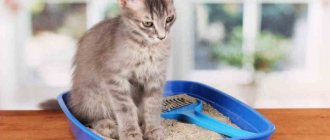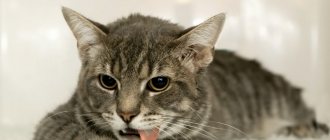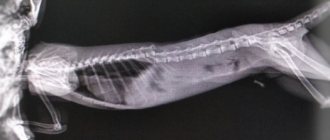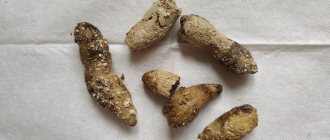Normal frequency of urination in cats
Kids go to the litter box several times a day, adult cats once, males - 1-2. There is no need to worry about going to the toilet more than twice as long as your pets are feeling well. It’s not a problem when cats double the number of trips during estrus, and neuters are emptied 6 times a day.
It is worse when there is urinary retention. If no traces of urine are found on the tray for more than two days, then the cat has anuria - a terrible symptom that can lead to overflow and rupture of the bladder and the death of the animal.
When to contact a veterinarian
The topic of infrequent urination in cats comes up quite often. However, sometimes owners simply cannot keep track of how often their pet pees. Most often, difficulties in this matter arise if the cat goes outside.
If you rarely let your cat drink, she may also have trouble urinating. She will not urinate much due to dehydration. Therefore, first of all, if you notice that your cat hardly pees, you need to make sure that there is always water available to her. If after this the symptom disappears, then there is no need to go to the veterinarian.
© shutterstock
Contacting him becomes inevitable if such symptoms are noted.:
- During urination, the cat screams or meows loudly.
- The cat pees too little or too much.
- The consistency, color or odor of the secreted fluid has changed.
- The cat became lethargic and sleepy.
- The animal refuses water or suffers from constant thirst.
- The pet's temperature rises.
These signs can be observed if the cat cannot go to the toilet for more than a day.
Symptoms of urinary retention in cats
Signs of urinary retention may not be immediately noticeable. When your pet feels discomfort, changes in his behavior will become noticeable.
Suspicion of urinary retention arises when the following symptoms are detected:
- frequent urges (pollakiuria) end in vain: the animal spins, fusses, but nothing comes of it;
- strangury occurs - painful urination, accompanied by a plaintive meow;
- blood appears in the urine (hematuria);
- the pet constantly licks the genitals;
- the cat does not play and becomes aggressive;
- if urine (urine) is released, it is drop by drop, with blood, pus and a pungent odor;
- when trying to pick up or touch the stomach, the pet growls and scratches;
- vomiting occurs;
- the cat stops drinking;
- convulsions develop.
Be sure to read:
Vomiting in a cat: causes, what different types of vomit indicate, first aid, treatment, when it is not dangerous
What to do?
Choosing the right algorithm of action if the cat did not write much the day before is not so difficult.
© shutterstock
Self-treatment
First, you need to remember everything that happened to her in recent days. Perhaps you transported your pet from one place of residence to another? Probably the cause of all the troubles is increased nervous tension. In this situation, you should ensure that your cat is as comfortable as possible. If the tray has been dry for the second day, and the cat periodically comes up and sadly paws at the litter, it may not be entirely comfortable for him in his own toilet. The fact is that if proud cats don’t like something, they will endure it on principle. Perhaps the tray has not been cleaned for a long time or there is not enough filler in it.
Try tidying up or adding pellets to the toilet. Also check to see if your cat is thirsty. Has the water decreased since the last time you filled the bowl? If not, you should force the cat to drink.
The cat cannot pee: reasons
The most common cause of the disease is urolithiasis. The lumen of the ureter is partially or completely blocked by urolith - a grain of sand or stone formed from precipitated urinary salts.
Statistics show that up to 12% of cats are susceptible to the disease, and predominantly males suffer. This phenomenon is due to the fact that they have a more tortuous and longer urethra than females.
Neutered pets get sick more often than unsterilized pets. This is explained by the fact that after removal of the gonads, the diameter of the ureter ceases to expand in proportion to the increase in live weight. An unbalanced diet, as well as poor water quality, are of great importance in the formation of uroliths. Persians, Siamese, Burmese, and Maine Coons are predisposed to the disease.
In addition to urolithiasis, urinary disorders occur for the following reasons:
- cystitis: inflammation of the bladder, the canal is inflamed, urine is released drop by drop, it hurts to write;
- urethritis - inflammation of the sphincter of the urethra, accompanied by its partial or complete blockage;
- disruption of innervation due to spinal injury;
- polyps on the walls of the bladder or in the urethra obstruct the outflow of urine or cause incontinence;
- kidney diseases.
Why does a cat pee a little?
A cat should pee, if it is already a year old, about 2 times a day. If urination does not occur for several days or a very small amount of urine is found in the tray, this indicates a malfunction in the body.
© shutterstock
This phenomenon can be caused by the following factors:
- Kidney diseases of congenital or acquired type.
- Urolithiasis (the most common reason why a cat doesn’t pee a lot).
- Inflammatory processes in the urethra or bladder. They can be caused by hypothermia or infection.
- Weakening of the bladder walls (atony). The reason for this may be an injury, surgery, illness, or age-related changes in the cat’s body.
- Anuria. This condition is characterized by the absence of urine and poses a threat to the animal's life.
- Spinal cord damage due to spinal injuries.
- Benign or malignant tumors.
Only a veterinarian can determine the reason why a cat pees little.
The cat cannot pee: treatment at home
If the cat is not placed on the operating table, he is prescribed conservative treatment, which the owner carries out at home. If the cat still produces urine, it is taken for analysis to establish or deny the presence of stones, as well as to determine their type.
Be sure to read:
Black feces in a cat: normal or pathological, when is it a dangerous symptom, diagnosis, how to treat
However, before a definitive diagnosis can be made, the animal must be treated immediately. The clinic may place a catheter to empty the urinary reservoir. If necessary, call a veterinarian who carries out the procedure at home.
After determining the type of stones, diet therapy is prescribed. It is necessary to use veterinary food, which helps dissolve already formed stones (urological stones) and prevents the loss of new ones. If the flow of urine is impaired due to kidney failure, use veterinary food for cats with kidney disease.
The pet will have to rebuild its lifestyle. Indefinite preventive feeding is prescribed. You will have to forget about eating natural products. The cat is prescribed herbal teas. At first, it is necessary to conduct quarterly examinations.
For exacerbations, antibiotics, antispasmodics (No-Shpa), and the drug Kot Erwin, which destroys stones, are prescribed.
Treatment options
In cases where the cat does not pee, only a veterinarian can decide on the choice of treatment. In a number of situations, only the fastest surgical intervention can save the life of an animal, so you cannot hesitate in such a situation.
Very often, owners are interested in what to do if the cat cannot pee. The animal must be shown to the veterinarian and await his conclusion. Depending on the disease, specific treatment will be prescribed.
If the disease is bacterial in nature, antibiotics will have to be used; in other cases, antiviral, anti-inflammatory, painkillers, diuretics, antihistamines and other drugs, as well as steroid hormones (if required), will be prescribed. These drugs must be given strictly according to doctor's orders.
A sick cat needs love, affection, a warm, cozy place to sleep, and proper feeding and drinking regimen. She will need a special diet of foods that cannot irritate diseased kidneys and urinary organs.
Dry food, especially cheap food, must be removed from her diet. It is not of high quality and has an extremely negative effect on urinary function. It contains few natural products, especially meat, and mainly contains carbohydrates, fats, various additives, flavors that attract cats, and dyes.
In addition, it contains a lot of salt, and swelling in the cat’s stomach, such food severely dehydrates the body. Long-term feeding of such foods in itself can lead to impaired kidney function, and in the presence of a disease this is especially dangerous.
During an acute condition, the kidneys should not be overloaded with protein foods, so a lot of attention should be paid to the cat’s nutrition. Until the condition stabilizes, her food should be light, natural, unprocessed and sufficient in calories.
Since urolithiasis in cats is a fairly common phenomenon, and it mostly affects cats, especially castrated cats, urethrostomy is used as a preventive or therapeutic measure. Due to the severe narrowing of the urethra at the exit, even a small amount of sand can lead to the death of the cat. The new urethral opening is created between the scrotum and the anus.
This operation can save the animal’s life, but will require more attention and care from the owners, since the frequency of bacterial cystitis can triple.
The kitten cannot go to the toilet
Little kittens do not go to the toilet on their own for more than 3 weeks after birth. The motor muscles of the baby's genitourinary system are not yet formed. The mother cat stimulates the elimination of urine and feces with a massage, licking the kittens' perineum and tummy. When the baby is one month old, he begins to urinate on his own 7-9 times a day. As you get older, the frequency of urination decreases up to 3-5 times.
Need to know! If an animal does not go to the toilet for a day, its body begins to smell unpleasant. Contact your veterinarian immediately.
Causes of urinary retention
The causes of the disease include colds, congenital anomalies, pathologies, and mental disorders.
Urinary retention is classified as:
- acute – complete cessation of urination, requires immediate medical intervention;
- chronic - urine is excreted in small portions, the bladder is not completely emptied.
Acute delay appears:
- in males – with prostatitis, prostatic hyperplasia;
- in females - with ectopic pregnancy, uterine prolapse.
The outflow of urine is impaired if the spinal cord and brain do not regulate the work of contractile muscles. This happens with spinal injuries, strokes, and spinal hernias. Males are more likely to suffer from this disease.
Reason 1. Urolithiasis
In animals, stones form in the urinary system - uroliths, oxalates. They close the urethral ducts, leading to the inability to urinate.
The development of the disease is promoted by:
- genetic predisposition of the breed;
- dehydration;
- sedentary lifestyle;
- unbalanced diet;
- increased levels of calcium in the blood.
When urine obstruction begins, animals begin to urinate frequently in small portions. When complete abstruation occurs, the urethra is blocked, the kitten cannot go to the toilet.
Urolithiasis often develops simultaneously with cystitis, because sand and stones injure the mucous membrane of the ducts, causing an inflammatory process.
Need to know! The following should be excluded from the diet of animals with a predisposition to urolithiasis:
- fish - phosphorus promotes the formation of stones;
- raw meat thickens and urine is more difficult to excrete;
- milk – contains magnesium, which prevents the flow of urine.
Animals are fed food with a high content of vitamins A, B, and glutamic acid.
Reason 2. Anuria
In kidney failure, organs lose their ability to produce urine. The acid-base metabolism and water-acid balance of the body are disrupted, which leads to intoxication.
Anuria occurs due to:
- heart failure;
- dehydration;
- taking medications, anesthesia;
- high blood pressure, blood clots;
- infections.
Anuria is a fatal stage of renal failure. With it, the kitten does not even feel the urge to urinate. A small chance of survival is possible if medical care is provided in a timely manner.
Reason 3. Cystitis
Cystitis develops against the background of infection in the bladder, obesity, exhaustion, mechanical damage to the urethra, hypothermia, weakened immunity, and stress.
Chronic cystitis is the most dangerous because it is asymptomatic. The chronic disease is incurable, so you must not miss the onset of acute cystitis, which has alarming signs.
Manifestation of the disease:
- dark colored urine with an unpleasant odor;
- swollen, hard belly, painful to the touch;
- elevated body temperature.
The kitten often comes to the toilet, trying to urinate, but to no avail. This behavior is caused by a painful inflammatory process.
For prevention, it is necessary to vaccinate the animal on time, avoid drafts and hypothermia.
Nutrition
Difficulties with the toilet are observed in cats that eat exclusively dry food. The risk increases if the animal is lazy, sedentary, and drinks little water. Urine gradually becomes thick, crystallizes, and urolithiasis develops.
Advice! Correct the kitten's nutrition from an early age.
Castration
After the operation, there is no natural emptying of the bladder for several days. Postoperative stress and caterization affect the psychological state of the cat and lead to further disruption of excretory functions.
After sterilization or castration, the metabolism of animals slows down, obesity appears, as a result, urolithiasis develops, and problems with the toilet begin.
Symptoms of difficulty urinating
You can notice the first signs of the disease by your pet’s behavior:
- walks around the toilet, meows pitifully;
- puts his paws in the tray and immediately comes out of it;
- meows painfully when trying to urinate;
- uncharacteristically stretches out its paws while licking itself;
- after trying to urinate, drops of blood remain on the toilet;
- dark-colored urine with a foul odor;
- the peritoneum is tense, the abdomen is painful.
The cat's tense posture when trying to go to the toilet and refusal to contact the owners should be alarming.
First aid
If the kitten cannot pass urine, it is examined independently and the bladder is carefully palpated. If the organ is compacted, enlarged, or the cat reacts painfully, contact a veterinarian immediately.
Before the doctor arrives:
- apply a heating pad to the pet’s stomach;
- give water to drink;
- instead of food they give chicken broth;
- lower the cat's lower body into a warm bath.
You can’t massage your cat’s belly – if stones are stuck in the ducts, this will lead to injury to the walls of the bladder.
It is prohibited to give painkillers, antispasmodics and other medications without a doctor’s prescription.
To drain urine, the doctor will insert a catheter into the kitten and prescribe further treatment. When remission occurs, the pet is given an infusion of sage, rose hips, horsetail, and plantain.
Need to know! Some animals are attracted to moving water. If a cat drinks little water, install a special fountain for it or periodically open the tap.











